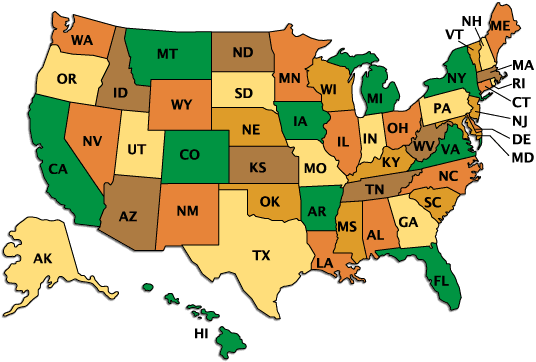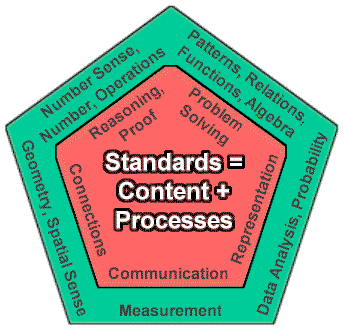Math Topics
Learning Support
Professional
![]()
 Enhance
your knowledge of standards and their implementation in your
instructional program. This section on state and
national standards contains:
Enhance
your knowledge of standards and their implementation in your
instructional program. This section on state and
national standards contains:
Other Best-Rated Education and Professional Standards Resources
Opposition to Standards and Mathematics Education Reform - materials to keep you informed
Education Research with selected articles about standards and making them work, raising achievement, assessment, and technology integration. The pages also address No Child Left Behind and scientifically based research, reading and conducting research, including action research, and research resources on the Web.
![]()
No Child Left Behind legislation required that states report test data in terms of their state academic standards. Educators must be knowledgeable of their state's standards so that they can plan instruction accordingly and then use the results of testing to inform their planning.
However, the problem educators face with standards is that there are so many of them, making it nearly impossible to address all within a school year, and not all are tested on accountability tests. Popham (2006a) addresses the need for measuring fewer curricular targets on state accountability tests, and notes that Kansas and Wyoming are examples of states making "courageous efforts to reduce state-assessed curricular aims to a manageable number" (p. 88).
Educators might monitor state-level tests in an attempt to determine what standards a test has actually been addressing over the past few years, and select content for instruction based on that decision. This latter may or may not work, as the next test might include questions on standards not taught.
Using such accountability results as a diagnostic of student strengths and weaknesses to inform instruction is also problematic. Reports accompanying test results often include breakdowns of student performance within identified subcategories. While these might be indicators for instructional planning, they should be used cautiously. According to Popham (2006b), the limited number of questions used on tests that fall within particular categories cannot truly indicate if a student "(1) possesses a key cognitive skill, or (2) has mastered a particular body of knowledge" (p. 90).
Your state department of education provides its state academic standards. For example, see the Academic Content Standards for Ohio.
American Education Reaches Out (Project AERO) has academic standards in mathematics, social studies, science, English language arts, and technology for American schools overseas. These are based on a condensed compilation of national standards identified by the Council for Basic Education.
Common Core State Standards Initiative for English language arts and Mathematics. The standards for mathematics are organized by grade level for Grades K-8. The high school math standards are organized by strand. Note: Educators might also appreciate the Common Core Toolkit, which includes resources for implementing the standards and a Common Core Video Series.
| Domains within the Common Core Math Standards | |||||||||
| K | 1 | 2 | 3 | 4 | 5 | 6 | 7 | 8 | HS |
| Counting & Cardinality | |||||||||
| Number & Operations in Base 10 | Ratios & Proportional Relationships | Number & Quantity | |||||||
| Number & Operations-Fractions | The Number System | Algebra | |||||||
| Operations & Algebraic Thinking | Expressions & Equations | Algebra | |||||||
| Operations & Algebraic Thinking | Functions | Functions | |||||||
| Geometry | Geometry | ||||||||
| Measurement & Data | Statistics & Probability | Statistics & Probability | |||||||
| Source: Common Core State Standards. (2010). Mathematics Standards. Washington, DC: National Governors Association Center for Best Practices, Council of Chief State School Officers. https://www.thecorestandards.org/Math/ | |||||||||
These databases provide benchmarks, information about school performance:
 HOT: June 2, 2010. The National Governors Association Center for Best Practices and the
Council of Chief State School Officers released the final form for a set
of state-led education standards for K-12 English-language arts and
mathematics, the
Common Core State
Standards.
HOT: June 2, 2010. The National Governors Association Center for Best Practices and the
Council of Chief State School Officers released the final form for a set
of state-led education standards for K-12 English-language arts and
mathematics, the
Common Core State
Standards.
HOT! In response to the call for a more coherent curriculum, the National Council of Teachers of Mathematics developed Curriculum Focal Points for Prekindergarten through Grade 8 Mathematics: A Quest for Coherence. This document identifies three important topics for mathematics at each grade level preK-8 and has been integral in the revision of many state math standards (NCTM, 2006). Focus in High School Mathematics: Reasoning and Sense Making (NCTM, 2009) addresses mathematics education in high school.
Learn about standards for the National Assessment of Educational Progress (NAEP) at the U.S. Department of Education Institute of Education Sciences. Readers should consider, however, that the NAEP is not considered a high stakes test. Gerald Bracey (2009) reported on characteristics that make it a poor accountability tool. For example, no student ever takes the entire test, nor do districts, schools, or individual students find out how they performed. Thus, students might not take NAEP as seriously as they would the ACT or SAT or their state high stakes tests (p. 33).
Programme for International Student Assessment (PISA) from the Organisation for Economic Co-Operation and Development surveys "15-year-olds in the principal industrialised countries. Every three years, it assesses how far students near the end of compulsory education have acquired some of the knowledge and skills essential for full participation in society." The U.S. is among participating countries. PISA assesses reading, mathematics, and science. Gerald Bracey (2009) also noted that PISA is not a high stakes test and points out flaws in using results as a measure of the quality of U.S. schools. Chief among those is comparing results of a nation with a diverse population of over 300-million people to results of small "homogeneous city-states like Hong Kong and Singapore." Formal schooling differs among nations as to when students start school, policies differ in relation to repeating grades, and schools might not be serving the entire population, particularly those from low-income families. The design of test items also fall into question when one considers difficulty in translating questions into several languages, and keeping those questions free of culture bias (p. 34).
Conclusions on the state of state standards differ, as the following reports dating back to 2005 from the Fordham Institute and Education Week illustrate. However, even with rise of a new era of Common Core Standards in 2010, controversy remains.
The Thomas B. Fordham Institute, based in Washington, DC, supports research, publications, and action projects of national significance in elementary and secondary education reform, as well as significant education reform projects in Dayton, Ohio and vicinity. It is associated with the Manhattan Institute for Policy Research. In The State of State Math Standards 2005, David Klein reported that only three states received "A" and five states "B" grades on their state math standards. Nine problem areas for which states come up short are addressed. Major findings:
There is an overemphasis on calculator use. Klein, while acknowledging the positive role that calculators can play in school mathematics with proper guidance and restrictions, states for elementary students, "the main goal of math education is to get them to think about numbers and to learn arithmetic. Calculators defeat that purpose" (p. 10).
There is decreased emphasis on memorization of "basic facts" in many states. According to Klein, "Students who do not memorize the basic number facts will founder as more complex operations are required, and their progress will likely grind to a halt by the end of elementary school" (p. 10).
"Only a minority of states explicitly require knowledge of the standard algorithms of arithmetic for addition, subtraction, multiplication, and division" (p. 10). Being able to use the standard algorithms and understand how and why they work is a foundational skill for elementary students.
Too little attention is paid to fraction development "in the late elementary and early middle grades; and there is not enough emphasis on paper-and-pencil calculations." At the high school level "much more attention is needed in the arithmetic of rational functions. Many state standards would also benefit from greater emphasis on completing the square of quadratic polynomials, including a derivation of the quadratic formula, and applications to graphs of conic sections" (p. 11).
There is too great an emphasis on patterns across K-12 standards. "[A]ttention given to patterns is far out of balance with the actual importance of patterns in K-12 mathematics" (p. 11).
There was concern for an overuse of manipulatives in that students might come to depend on them and focus on the manipulatives more than on the math. "[M]any state standards recommend and even require the use of a dizzying array of manipulatives in counterproductive ways" (p. 11). Klein states that manipulatives are useful for introducing new concepts to elementary students, but, "In the higher grades, manipulatives can undermine important educational goals" (p. 11).
There is a tendency to overemphasize estimation at the expense of exact arithmetic calculations.
Concern was raised about probability and statistics study beginning in Kindergarten, and excessive data collection standards. "Statistics and probability requirements often crowd out important topics in algebra and geometry" (p. 11).
"[F]ew states offer standards that guide the development of problem-solving in a useful way. Likewise, mathematical reasoning should be an integral part of the content at all grade levels. Too many states fail to develop important prerequisites before introducing advanced topics such as calculus" (p. 11).
The report included four suggestions for improvement in state math standards. Of most value, perhaps, is the suggestion that states borrow a complete set of high-quality math standards from a top-scoring state, such as California, Indiana, and Massachusetts. These latter were the three states that received an "A" grade for their "standards' clarity, content, and sound mathematical reasoning, and the absence of negative features" (p. 9), which were the criteria used to judge the math standards in states. Also states should use authors of standards documents who thoroughly understand mathematics. States should develop coherent arithmetic standards emphasizing both computational fluency (How about good ol' paper and pencil as your manipulative?) and conceptual understanding. Finally, states should avoid problems in mathematical development resulting from overuse of calculators and manipulatives, overemphasis of patterns and probability and statistics, and insufficient development of standard algorithms and fraction arithmetic (p. 25).
Fordham's review of state math standards is only one perspective and caution should be exercised in completely accepting or completing ignoring the results of their study. However, results give states relevant feedback to consider when policymakers, practitioners, and mathematicians meet to examine and revise standards, hopefully on a regular basis.
Readers might get an entirely different view of their state standards by examining reports from Education Week. For example, in its State Report Card, part of Quality Counts 2005, which takes a broader look at standards, Ohio was one of 12 states that earned A's in the category of standards and accountability for its "clear and specific standards in English, mathematics, and science for elementary, middle, and high schools" (Ohio Report Card section, par. 1). Compare this to Fordham's rating of "D" for Ohio's math standards, and Klein's statement in their report (2005) that "Ohio’s 2001 revision of its math standards turned out to be a dreadful mistake. There are serious deficiencies in these standards, including coverage of arithmetic and the algebra indicators" (p. 92).
Likewise, Education Week (2006) reported in its Quality Counts at 10: A Decade of Standards-Based Education that Ohio again earned a high mark (A-) "for policies related to standards and accountability. Ohio scores particularly well in the area of academic standards. Its standards for the four core subjects at nearly every grade span have been rated as clear, specific, and grounded in content by the American Federation of Teachers" (Ohio's State Highlights section, para. 2).
The Common Core Standards Initiative ushered in a new era on state standards for math and English language arts in 2010. The CCSS have become controversial.
HOT: September 1, 2014:
The Education Commission of the States released its report on the Common
Core Standards,
States and the (not so) new standards — where are they now?
by Tonette Salazar and Kathy Christie. "This brief provides a sampling of
state legislative activity and executive branch action around the CCSS through Sept. 1, 2014. It is not intended to
be an exhaustive list; rather, it is narrowly focused on the single issue of
state affirmation, modification or replacement of the Common Core" (para.
2). Within the Appendix are state names for Common Core Standards.
HOT: November 13, 2017: Achieve, Inc. released a report, Strong Standards: A Review of Changes to State Standards Since the Common Core. Twenty-four of the 45 states and the District of Columbia that adopted the CCSS in 2010 have revised their English Language Arts and Math standards, largely due to political influences or "associated opposition to testing and accountability policies" (p. 2). Further, "across the country and with very few exceptions, the quality of state standards is significantly higher now than prior to the development of the Common Core" (p. 3). Per Achieve, "The report found that most states kept their standards rigorous and maintained college- and career-ready expectations for students."
September 5, 2018: Since 2010, state math standards have improved in four ways per David Griffith (2018) of the Fordham Institute with "much of that improvement due to the Common Core math standards" (para. 1). Those ways include:
Keep up with NEA news on Common Core State Standards: https://www.nea.org/professional-excellence/student-engagement/tools-tips/common-core-101 NEA's position on the CCSS is: "NEA believes the Common Core State Standards have the potential to provide all childen access to a complete and challenging education" (NEA, 2013, p. 3). However, in a letter to NEA members in 2014, then NEA President, Dennis Van Roekel, voiced concerns about implementation of the standards, indicating that "in far too many states, implementation has been completely botched" (para. 6). He provided advice to policy makers on what to do to make the standards work.
See the Frequently Asked Questions about the CCSS. In answering Why is the sequence of key math topics in the math standards important?, you'll find: "The mathematical progressions, or sequencing of topics, presented in the Common Core State Standards are coherent and based on evidence. Part of the problem with having many different sets of state standards was that different states covered different topics at different grade levels. Coming to a consensus on the standards guarantees that, from the viewpoint of any given state, topics will move up or down in a consistent grade level sequence. What is important to keep in mind is that the progression in the Common Core is mathematically coherent and leads to college and career readiness at an internationally competitive level." (FAQ, p. 7)
Web sites listed below provide additional information on professional math standards, teaching standards, implementing standards, and standards-based instructional materials.
Awesome Library has organized the Web with 37,000 carefully reviewed resources.
International Society for Technology in Education (ISTE) Standards has identified technology standards for students, educators, administrators, coaches, and computer science educators.
The K-12 Mathematics Curriculum Center "was funded by the National Science Foundation to inform and assist schools and districts as they select and implement standards based mathematics curricula." The Center was a project at Education Development Center from 1997 to 2007. Publications and research are available.
MiddleWeb receives support from the Clark Foundation's Program for Student Achievement and Office of Communication and provides links, resources, and original reporting to individuals interested in urban middle school reform and raising student achievement. It offers a focus on classroom assessment, academic standards, and performance-based teaching. Subject matter resources, including mathematics, are provided.
National Board for Professional Teaching Standards includes five core propositions that outline what the National Board values and believes should be honored in teaching. The NBPTS Standards detail what constitutes accomplished teaching in every subject and for students at all stages of their development. National Board Certification® is addressed.
National Center for Research on Evaluation, Standards, and Student Testing (CRESST) "conducts research on assessment, evaluation, methodology, and technology to improve learning and outcomes." Multiple publications, games, and simulations are available. You can also sign-up for its newsletter.
National Standards for Quality Online Learning (2024) provides three sets of relevant standards for educators involved with blended learning and online learning. These are National Standards for Quality Online Teaching, Online Programs, and Online Courses. This initiative is "led by a partnership between Quality Matters, the Virtual Learning Leadership Alliance, and the Digital Learning Collaborative with widespread community support." (About section)
PBS LearningMedia includes resources for preK-13+ math searchable by grade level and standards. Narrow a search with media type and subject.
 Principles and Standards for School Mathematics by the National Council of Teachers of
Mathematics is online along with a host of e-resources and interactive
activities that support standards. An overview of preK-12 principles and
standards is available.
Curriculum Focal Points (NCTM, 2006) expands on the document with the most important math
topics for each grade level preK-8. Focus
in High School Mathematics: Reasoning and Sense Making (NCTM, 2009) addresses mathematics
education in high school.
Principles and Standards for School Mathematics by the National Council of Teachers of
Mathematics is online along with a host of e-resources and interactive
activities that support standards. An overview of preK-12 principles and
standards is available.
Curriculum Focal Points (NCTM, 2006) expands on the document with the most important math
topics for each grade level preK-8. Focus
in High School Mathematics: Reasoning and Sense Making (NCTM, 2009) addresses mathematics
education in high school.
Professional Standards for Teaching Mathematics is by the National Council of Teacher of Mathematics: [access with your membership] or see https://www.nctm.org/store/Products/Professional-Standards-for-Teaching-Mathematics/
For example, Standard 4: Tools for Enhancing Discourse
The teacher of mathematics, in order to enhance discourse, should encourage and accept the use of:
 In
Getting Our NETS Worth: The Role of ISTE's National Educational Technology
Standards, M. D. Roblyer (2003) noted that the dissent of those who oppose
student standards stems from three different perspectives:
In
Getting Our NETS Worth: The Role of ISTE's National Educational Technology
Standards, M. D. Roblyer (2003) noted that the dissent of those who oppose
student standards stems from three different perspectives:
Standards as Beginnings vs. Endings. Standards should be viewed as guidelines or benchmarks for performance. The problem is when standards turn into standardization, forcing educators to put children into a "one size fits all curriculum," which is unrealistic and self-defeating.
Authentic Standards vs. the Evil Twin: High Stakes Testing. High stakes testing has caused curriculum to become test-driven in many states.
Testing vs. Accountability Systems. There is a difference between standards-based testing and the use of test results to inform decisions regarding students, teachers, policies, and funding. The problem might not be testing, but rather the accountability system that upsets people. Such systems should have positive, formative effects and not negative, punitive ones.
AlfieKohn: Kohn is one of the most vocal opponents of the standards movement. The site contains strategies for coping with standards, and ways to develop organized opposition to standards. Numerous articles are included.
National Center for Fair & Open Testing (FairTest) is an advocacy organization working to end the abuses, misuses and flaws of standardized testing and ensure that evaluation of students is fair, open, and educationally sound. Broad concerns at K-12 include:
Bracey, G. (2009, November). The big tests: What ends do they serve? Educational Leadership, 67(3), 32-37. https://www.ascd.org/el/articles/the-big-tests-what-ends-do-they-serve
Education Week. (2005, January). Quality counts 2005: No small change, Targeting money toward student performance. Education Week, 24(17). https://www.edweek.org/policy-politics/quality-counts-2005-no-small-change
Education Week. (2006, January). Quality counts at 10: A decade of standards-based education. Education Week, 25(17). https://www.edweek.org/teaching-learning/quality-counts-2006-a-decade-of-standards-based-education
Griffith, D. (2018, September 5). Four ways state math standards have improved [Commentary]. https://fordhaminstitute.org/national/commentary/four-ways-state-math-standards-have-improved
Klein, D. (2005, January). The state of state math standards 2005. Washington, DC: Thomas B. Fordham Institute. https://fordhaminstitute.org/national/research/state-state-math-standards-2005
National Council of Teachers of Mathematics. (2006). Curriculum focal points for prekindergarten through grade 8 mathematics: A quest for coherence. Reston, VA: Author. https://www.nctm.org/store/Products/Curriculum-Focal-Points-for-Prekindergarten-through-Grade-8-Mathematics-A-Quest-for-Coherence/
National Council of Teachers of Mathematics. (2009). Focus in high school mathematics: reasoning and sense making. Reston, VA: Author. https://www.nctm.org/store/Products/Focus-in-High-School-Mathematics--Reasoning-and-Sense-Making/
National Education Association. (2013). NEA Common Core State Standards Toolkit. http://www.smmcta.com/uploads/9/9/4/2/9942134/common_core_toolkit_nea.pdf
Popham, J. (2006a, September). All about accountability/ Content standards: The unindicted co-conspirator. Educational Leadership, 64(1), 87-88. https://www.ascd.org/el/articles/content-standards-the-unindicted-co-conspirator
Popham, J. (2006b, October). All about accountability/ Diagnostic assessment: A measurement mirage? Educational Leadership, 64(2), 90-91. https://www.ascd.org/el/articles/diagnostic-assessment-a-measurement-mirage
Roblyer, M. D. (2003, May). Getting Our NETS Worth: The Role of ISTE's National Educational Technology Standards. Learning & Leading with Technology, 30(8), 6-13.
![]()
![]() Continue:
Go to Education Research
Continue:
Go to Education Research